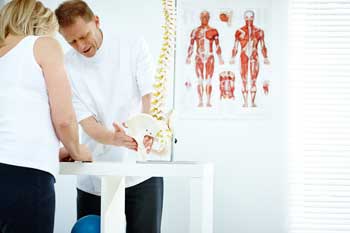
Evidence suggests approximately 34 percent of people who experience acute low back pain will suffer recurrent episodes (Journal Pain, 2009). One theory is that patients with an episode of acute low back pain lose motor control (ability to orderly and quickly contract muscles) of the deep muscle fibers of the lumbar spine. A recent research article demonstrated the connection between altered deep low back muscle activity and recurrent low back pain. It was shown that the recurrent low back muscle (multifidus muscle) activity occurred later in the participants with low back pain then the normal population without back pain (Spine, April 2010). Since the multifidus muscle is an important stabilizer of the spine, any delay in muscle firing may lead to abnormal spinal movement.
If there is a delay in muscle activation the body may not be able to handle simple loading of the spine. For example, you “throw your back out” by simply sneezing or picking up a small object. Furthermore, studies have shown that atrophy of the low back muscles does occur with chronic low back pain further lending to the problem.
In physical therapy we proactively try to work these and other muscle groups in order to treat the chronic low back pain or to prevent chronicity in those having their first episode of low back pain. Rehabilitation of these and other muscle groups is essential. Exercises are geared at working the abdominals (rectus abdominus, inter obliques, external obliques, and transverse abdominus muscles) with the back extensors (multifidus, erector spine). Exercises are also very specific and pointed at working endurance, strength, and motor control.
Although we talk specifically about spinal rehabilitation one should never forget the importance of manual therapy (use of hands in treating muscles and joints). Manual therapy (manipulation, Fascial Manipulation, Active Release, Graston techniques) has been shown to influence muscle function by normalizing the muscle and joint function (JOSPT, Oct 2007).
Beyond this, a combination of physical therapy techniques such as: stretching, strengthening, aquatic therapy, patient education, and modalities (ice, heat, ultrasound, electric stimulation) retain the goal of treating the cause of the problem and preventing it from returning.
If pain is limiting you from doing the activities you enjoy, give Mishock Physical Therapy a call for a Free Phone Consultation at (610) 327-2600. Also, visit our website to read more physical therapy related articles, learn more about our treatment philosophy, our physical therapy staff, and our 6 convenient locations in Gilbertsville, Skippack, Barto, Phoenixville, Limerick, and Stowe (Pottstown) at www.mishock.wpengine.com. Our mission is to exceed the expectations of our patients by providing excellence in care and service. We are here to serve you!
Dr. Mishock is one of only a few clinicians with doctorate level degrees in both physical therapy and chiropractic in the state of Pennsylvania.
* Phone Consultations are not applicable to patients in federal or state funded programs, such as Medicare and Medicaid.
* Screenings are consultations and do not involve a physical therapy evaluation or treatment.
